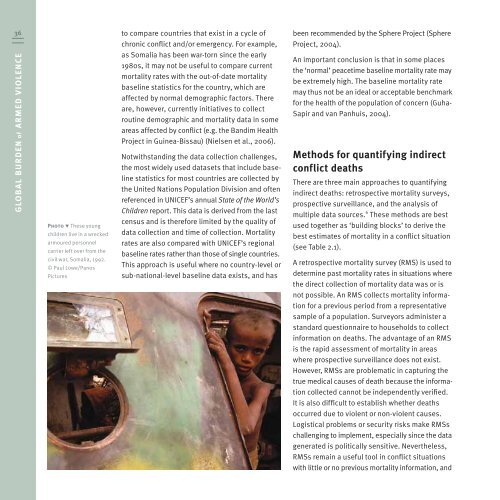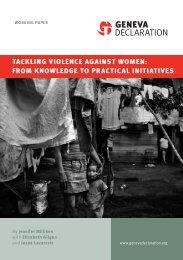Global Burden of Armed Violence - The Geneva Declaration on ...
Global Burden of Armed Violence - The Geneva Declaration on ...
Global Burden of Armed Violence - The Geneva Declaration on ...
You also want an ePaper? Increase the reach of your titles
YUMPU automatically turns print PDFs into web optimized ePapers that Google loves.
36 to compare countries that exist in a cycle <str<strong>on</strong>g>of</str<strong>on</strong>g><br />
chr<strong>on</strong>ic c<strong>on</strong>flict and/or emergency. For example,<br />
as Somalia has been war-torn since the early<br />
1980s, it may not be useful to compare current<br />
mortality rates with the out-<str<strong>on</strong>g>of</str<strong>on</strong>g>-date mortality<br />
base line statistics for the country, which are<br />
affected by normal demographic factors. <str<strong>on</strong>g>The</str<strong>on</strong>g>re<br />
are, however, currently initiatives to collect<br />
routine demographic and mortality data in some<br />
areas affected by c<strong>on</strong>flict (e.g. the Bandim Health<br />
Project in Guinea-Bissau) (Nielsen et al., 2006).<br />
GLOBAL BURDEN <str<strong>on</strong>g>of</str<strong>on</strong>g> ARMED VIOLENCE<br />
Photo " <str<strong>on</strong>g>The</str<strong>on</strong>g>se young<br />
children live in a wrecked<br />
armoured pers<strong>on</strong>nel<br />
carrier left over from the<br />
civil war, Somalia, 1992.<br />
© Paul Lowe/Panos<br />
Pictures<br />
Notwithstanding the data collecti<strong>on</strong> challenges,<br />
the most widely used datasets that include baseline<br />
statistics for most countries are collected by<br />
the United Nati<strong>on</strong>s Populati<strong>on</strong> Divisi<strong>on</strong> and <str<strong>on</strong>g>of</str<strong>on</strong>g>ten<br />
referenced in UNICEF’s annual State <str<strong>on</strong>g>of</str<strong>on</strong>g> the World’s<br />
Children report. This data is derived from the last<br />
census and is therefore limited by the quality <str<strong>on</strong>g>of</str<strong>on</strong>g><br />
data collecti<strong>on</strong> and time <str<strong>on</strong>g>of</str<strong>on</strong>g> collecti<strong>on</strong>. Mortality<br />
rates are also compared with UNICEF’s regi<strong>on</strong>al<br />
baseline rates rather than those <str<strong>on</strong>g>of</str<strong>on</strong>g> single countries.<br />
This approach is useful where no country-level or<br />
sub-nati<strong>on</strong>al-level baseline data exists, and has<br />
been recommended by the Sphere Project (Sphere<br />
Project, 2004).<br />
An important c<strong>on</strong>clusi<strong>on</strong> is that in some places<br />
the ‘normal’ peacetime baseline mortality rate may<br />
be extremely high. <str<strong>on</strong>g>The</str<strong>on</strong>g> baseline mortality rate<br />
may thus not be an ideal or acceptable benchmark<br />
for the health <str<strong>on</strong>g>of</str<strong>on</strong>g> the populati<strong>on</strong> <str<strong>on</strong>g>of</str<strong>on</strong>g> c<strong>on</strong>cern (Guha-<br />
Sapir and van Panhuis, 2004).<br />
Methods for quantifying indirect<br />
c<strong>on</strong>flict deaths<br />
<str<strong>on</strong>g>The</str<strong>on</strong>g>re are three main approaches to quantifying<br />
indirect deaths: retrospective mortality surveys,<br />
prospective surveillance, and the analysis <str<strong>on</strong>g>of</str<strong>on</strong>g><br />
multiple data sources. 6 <str<strong>on</strong>g>The</str<strong>on</strong>g>se methods are best<br />
used together as ‘building blocks’ to derive the<br />
best estimates <str<strong>on</strong>g>of</str<strong>on</strong>g> mortality in a c<strong>on</strong>flict situati<strong>on</strong><br />
(see Table 2.1).<br />
A retrospective mortality survey (RMS) is used to<br />
determine past mortality rates in situati<strong>on</strong>s where<br />
the direct collecti<strong>on</strong> <str<strong>on</strong>g>of</str<strong>on</strong>g> mortality data was or is<br />
not possible. An RMS collects mortality informati<strong>on</strong><br />
for a previous period from a representative<br />
sample <str<strong>on</strong>g>of</str<strong>on</strong>g> a populati<strong>on</strong>. Surveyors administer a<br />
standard questi<strong>on</strong>naire to households to collect<br />
informati<strong>on</strong> <strong>on</strong> deaths. <str<strong>on</strong>g>The</str<strong>on</strong>g> advantage <str<strong>on</strong>g>of</str<strong>on</strong>g> an RMS<br />
is the rapid assessment <str<strong>on</strong>g>of</str<strong>on</strong>g> mortality in areas<br />
where prospective surveillance does not exist.<br />
However, RMSs are problematic in capturing the<br />
true medical causes <str<strong>on</strong>g>of</str<strong>on</strong>g> death because the informati<strong>on</strong><br />
collected cannot be independently verified.<br />
It is also difficult to establish whether deaths<br />
occurred due to violent or n<strong>on</strong>-violent causes.<br />
Logistical problems or security risks make RMSs<br />
challenging to implement, especially since the data<br />
generated is politically sensitive. Nevertheless,<br />
RMSs remain a useful tool in c<strong>on</strong>flict situati<strong>on</strong>s<br />
with little or no previous mortality informati<strong>on</strong>, and









